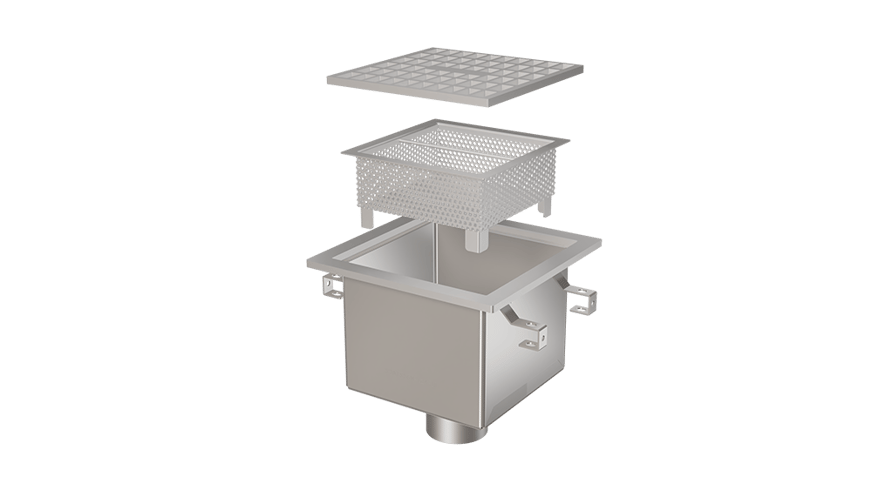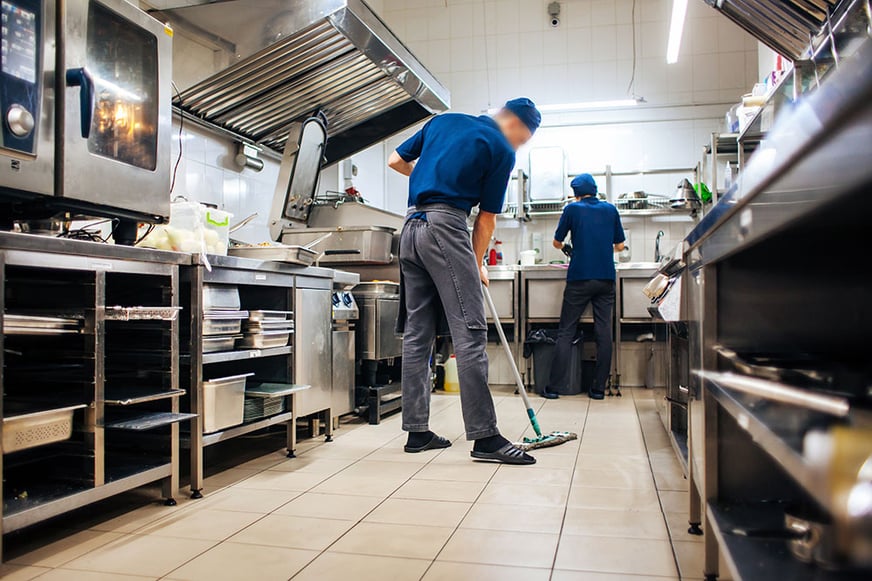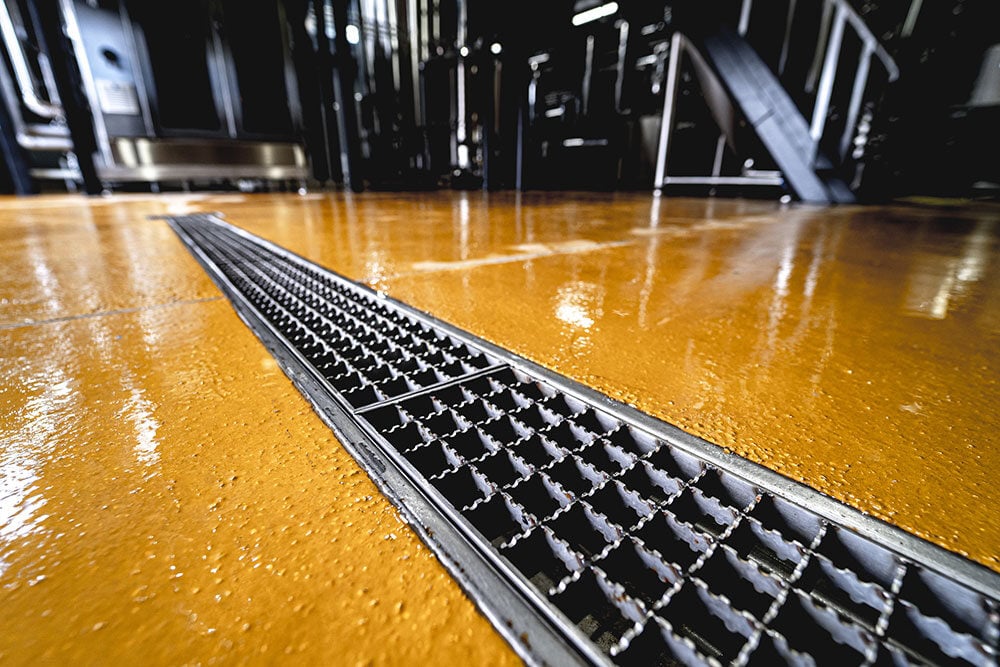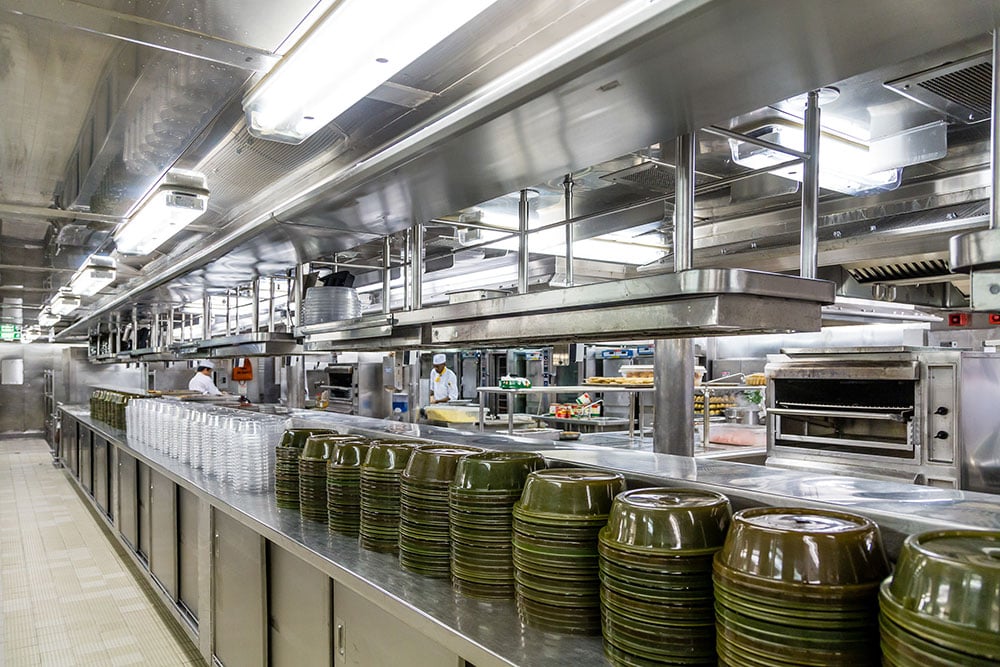Every food and beverage facility manager understands the importance of floor drainage. Drainage systems are critical to maintaining a safe clean and sanitary facility. Maintaining a high level of cleanliness requires hygienic equipment including FoodSafe floor drains and floor sinks. These tools are in place to collect excess liquid keeping floors free from standing water and debris that can cause bacteria growth and lead to food contamination.
Understanding what a floor sink is, and the difference between floor sinks and floor drains, is essential to choosing the correct drainage option for your facility. Floor sinks are a crucial part of a clean and sanitary drainage system. Having the right drainage in the right area is crucial to running a productive, safe and sanitary food facility.
What is a Floor Sink?

Floor Sinks are a type of floor-mounted service sink, typically deeper than a standard floor drain, Floor sinks are designed to handle indirect waste, such as water from dishwashers or cleaning operations, and can accommodate larger amounts of water and debris than standard floor drains. They are often grated and contain integrated strainer baskets to separate solids and liquids to prevent clogging of underground plumbing.
A floor sink is a type of floor drain designed for commercial applications, including the food and beverage industry. But wait, floor sinks are a type of floor drain? Wasn't this article supposed to explain the differences between a floor sink and a floor drain? Well yes and no. What this article is actually here to do is to explain what a floor sink is and the difference between floor sinks and other types of floor drains.
What is a Floor Drain?

Floor drain is a blanket term used to refer to many types of visible openings meant to collect water and divert it into underground plumbing. There are many different types of floor drains but some of the most common are
- Floor Sinks
- Area Drains
- Trench Drains
- Slot Drains
Floor drains are made to fit flush with the finished floor. The floor is often sloped towards floor drains. Floor drains provide a purpose built channel for liquids to enter to keep floors dry. Floor drains can be made from many different materials including plastic, concrete polymer, aluminum and stainless steel. Food and beverage facilities should always install stainless steel drains as other materials can be difficult to clean hygienically. Non-hygienic drains can trap debris leading to the growth of bacteria. This poses a contamination risk which can lead to food borne illness. For this reason food facilities should always ensure they install floor drains (like floor sinks) that are made from food grade stainless steel.
How Does a Floor Sink Compare to a Floor Drain?

We get this question a lot but as you can now see it is not entirely accurate. Because a floor sink is a type of floor drain you cannot compare the two. What you can do is compare a floor sink to other types of floor drains like, area drains, trench drains and slot drains.
A floor sink is most comparable to an area drain. A floor sink typically holds more volume than an area drain and is used for different purposes. An area drain is a square or round drain meant to drain areas of 400 square feet or less. The floor around an area drain is designed to slope towards the drain. This allows liquids to flow towards the drain and enter the underground drainage system.
A floor sink is purpose built to drain a specific piece of equipment like a dishwashing sink or a processing machine. It is not made to drain the floor, it is meant to handle high volumes of liquid and debris from a single source and to filter it before it enters the underground plumbing. Because of this the floor is generally not sloped towards a floor sink like it is towards a floor drain.
Where are Floor Sinks Used?

Floor sinks are usually placed in areas that could encounter more solids or higher volumes of liquid than the rest of the floor. They provide a secondary basin and strainer system to accommodate water before it enters the underground plumbing. An example is a dishwashing sink in a restaurant. Rather than draining the dishwashing sink directly into the underground plumbing a floor sink is placed below the drain pipe of the dishwashing sink. The dishwashing sink then drains into the floor sink. This allows for easy cleaning of the floor sink and prevents issues with the underground plumbing.
A floor sink is ideal if you have commercial appliances requiring drainage. They are especially ideal if the equipment requires an air gap. An air gap is a break between the plumbing on the bottom of a piece of equipment and the underground plumbing. Air gaps allow for easier cleaning and greater modularity than hard connections. Floor sinks are often installed in areas that require an air gap.
Area Drains
Area Drains are point drains designed for either indoor or outdoor use. They are generally constructed with a removable grate to allow for access and cleaning of the underground piping. Area drains are normally either round or square and can vary in size from a few inches in diameter to a foot or more. FoodSafe Drains offers a wide variety of area drains.
FoodSafe Drains Advantage
- T304 and T316 stainless steel construction
- Hygienic no niche construction
- Forklift rated
- Integrated strainer basket for easy cleaning
- Tamper proof designs available
_web-1.png?width=600&height=600&name=FSADR512-84CONE-(JUST-LID-EXPLODED)_web-1.png)
Trench Drains
A trench drain is a linear drainage system designed to quickly and efficiently remove excess surface water by using a trough-shaped channel covered with a grate. FoodSafe Drains offers a wide variety of trench drains.
FoodSafe Drains Advantage
- T304 and T316 stainless steel construction
- Hygienic no niche construction
- Forklift rated
- Large openings allow for higher flow rates; systems can be 6" or 12" wide.
- Compatible with clean-in-place technology.

Slot Drains
A slot drain is a linear drainage system characterized by a narrow, elongated slot-like opening that allows water to enter the drainage channel, unlike traditional trench drains which have a grated cover. FoodSafe Drains offers a wide variety of Slot Drain Systems.
FoodSafe Drains Advantage
- T304 and T316 stainless steel construction
- Flow rates up to 27 GPM
- Hygienic construction
- Forklift rated
- Compatible with clean-in-place technology.

CONSIDER YOUR DRAINAGE CAREFULLY

Understanding the differences between a floor sink and the other types of floor drains is vital in choosing the right solution for your needs. While all are effective drainage options, their purposes are very different. Selecting the right drain for the right area will provide effective drainage throughout your entire facility and help maintain a safe and sanitary working environment.
With all the different options of floor drains available choosing the right ones for your facility can be overwhelming. FoodSafe Drains has trained sales staff that can help to guide you through design and purchase of your drainage system. Contact us today to learn more about FoodSafe Drains: Floor Sinks, Area Drains, Trench Drains and Slot Drain Systems and to get expert advice on the best drainage layout for your facility.


